Wiener's/Wiesner's/Singleton's 'Moth' – why so many names attached?
(extract from below)
Wiener wanted the theories put to a practical test. In the late 1940s he teamed up with Dr. J. Wiesner, then in the Research Laboratory of Electronics, and later to become the president of MIT, to build a demonstration-machine with two feedbacks that would play a purposive and postural role, respectively, and exhibit the two types of tremors known to physiologists.
The machine they built, with help from H. Singleton, was a small tricycle cart, with two photocells facing front, one on the right side and one on the left. The output from the cells, after amplification, reaches the tiller controlling the front steering wheel. Depending on the direction of the output voltage, the cart is steered either towards or away from the quadrant with more intense lighting, thus behaving either like a "moth" or like a "bedbug". In either case it acts like a purposive mechanism, either pro- or anti-phototropic. The feedback involved, from light source to cell to tiller, and back, is voluntary, for "voluntary action is essentially a choice among tropisms" [56g, p. 166]. When the amplification is increased, however, the feedback becomes excessive, and forces the cart to overdo its movements, thereby getting it into oscillation, as in purpose or intention tremor.
Also built into the cart was a secondary feedback attached to the tiller, and so arranged that it could be overloaded even with little or no output from the photo cells. In the absence of light this became excessive and the tiller started oscillating. This secondary feedback played a postural role, and the second tremor exemplified Parkinsonianism.
This tiny "moth-bedbug" somehow drew the attention of the United States Medical Corp. They photographed its tremors in order to compare their profiles with those of human tremors, and so enhance the knowledge of army neurologists.
(next two photo's are sourced from Google images, Source:life)
At first glance the trace appears somewhat confusing. There's 2 traces, one starts and stops. The other appears as if the cart (in moth-mode) is bouncing off the corridor walls. The photo shows the cart before the trace, so it is travelling away from you (ie up the page).
This is what you are really observing: The 'thinner' trace starting in the middle of the photo is someone holding a torch, then they move backwards down the corridor going from side to side with the cart following suit. Other than using the cart for studing oscillations/tremors, it wasn't real exciting in my opinion. Bedbug-mode added another dimension, but not much really. Possibly why Wiener failed to see, or look for and understand the difference between his and W. Grey Walter's tortoises.
Update: 28 Apr 2010 – More images of cart
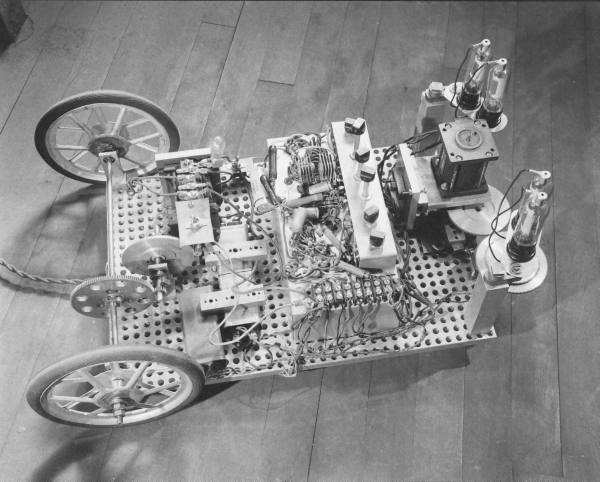

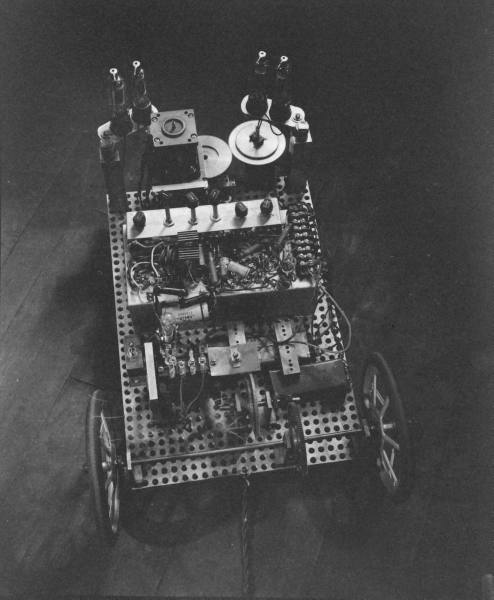
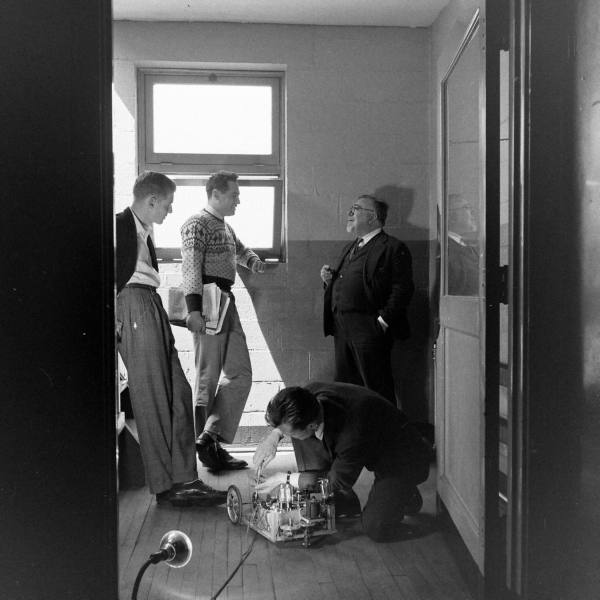
From Wiener’s “the human use of human beings”…. (1950 ed.)
I have recently received a letter from Dr. Grey Walter of the Burden Neurological Institute at Bristol, England, in which he expresses interest in ’the moth’ or ‘bedbug,’ and in which he tells me of a similar mechanism of his own, which differs from mine in having a determined but variable purpose. In his own language, ‘We have included features other than inverse feedback which gives to it an exploratory and ethical attitude to the universe as well as a purely tropistic one.’ The possibility of such a change in behavior pattern is discussed in the chapter of this book concerning learning, and this discussion is directly relevant to the Walter machine, although at present I do not know just what means he uses to secure such a type of behaviour. The moth and Dr Walter’s further development of a tropism machine seen to be at first sight exercises in virtuosity, or at most, mechanical commentaries to a philosophical text.’
Later, from Weiner’s expanded 1952 edition
“here let me mention some earlier machines of Dr. Walter, somewhat similar to my ‘moth’ or ‘bug,’ but which were built for a different purpose. For these phototropic machines, each element carries a light so that it can stimulate the others. Thus a number of them put into operation at the same time show certain groupings and mutual reactions which would be interpreted by most animal psychologists as social behaviour if they were found encased in flesh and blood instead of brass and steel. It is the beginning of a new science of mechanical behaviour even though almost all of it lies in the future."
——————————
"The Way Things Work" 1969 (Translated from the German)
CYBERNETICS IN PHYSIOLOGY
The interactions between the external world and the actions of a human being who receives information about that world through the senses can be understood with the aid of the concepts and principles of cybernetics. This is illustrated by a simple experiment that we can perform for ourselves. I place an object —a pencil, for example — on the table and then pick it up. I perceive the position of the pencil through my sense of sight. This visual information is transmitted through nerves to the appropriate centre in my brain, where it is "processed," and whence the necessary instructions to grasp the pencil are issued, through other nerves, to the muscles of my arm and hand. In performing this action, the movements of the arm are monitored by the eyes and optimally guided. When I close my eyes, this monitored guidance of my movements is absent. My hand now no longer goes unerringly to the pencil, but has to grope about until the pencil reveals itself to another of my senses, namely, the sense of touch. This experiment shows that the control exerted over these movements through visual feedback is much more effective than the control provided by tactile feedback. The latter is in fact so poor that my hand does not perform a direct movement at all, but oscillates about while seeking the pencil. This illustrates the typical behavior of a control loop with a very low degree of feedback: it oscillates. Thus we here have a process eminently suited for study by the methods of information theory, or cybernetics. But the transmission of sensory stimuli by the nervous system is not merely a process formally describable in terms of information theory; it is also, in reality, a form of electrical transmission. The sensory nerve cells, for example, in the eye or ear, receive a stimulus from the external world. This stimulus is converted into an electrical potential and is transmitted, in the form of impulses, to the next nerve cell. The whole nervous system is composed of nerve cells (neurons) which are its structural and functional units.
Each neuron consists of the cell-body, a single long nerve fibre (axon), which carries impulses away from the cell-body, and a number of short dendrites, which receive impulses from the axons of other neurons. The axon, which is the actual information channel, may be several feet in length and has a diameter of about 0.0001 cm (0.00004 inch). The cell-body itself may be compared to an amplifier with two states of equilibrium. It can be either in the state of rest or in the working state, operating in the manner of a relay with an "off" and an "on" position. The state of the cell at any given instant, therefore, corresponds to a binary digit or bit. The extremity of the axon terminates at a dendrite, or at the cell-body of the next neuron. At the actual junction, the current path is interrupted by a discontinuity called the synapse, which is comparable to a toroidal transformer that serves as a galvanic separation between transmission channels and forms an inductive connection between them. Inside the synapse, a form of electrolytic transmission takes place, the actual "gap" being approximately a hundred-thousandth of a millimetre wide. At the synapse, the impulse is passed on by acetylcholine, a substance that is secreted there and which stimulates the adjacent neuron. Like every flip-flop circuit, the neuron, too, has a relaxation time, that is, it requires a certain length of time before it is ready to respond to another impulse. In physiology this is known as the refractory period, and it is of the order of 0.5 to 1 millisecond.
The velocity of propagation of an impulse in a nerve cell is approximately 120 m/sec. (400 ft./sec.), corresponding to about one-third of the velocity of sound. A number of neurons serving as successive amplifier cells are connected between the receptor (sense-organ, such as eye, ear, and so on) and the brain. The resting potential has a negative value: approximately -60 to -80 millivolts; the action potential is positive: +90 to +100 millivolts. The axons, often as many as two or three thousand, are grouped together in bundles (the nerves), which resemble cables and form complex intermeshed and interlinked networks. The intermeshing ensures that the sensory stimuli are transmitted not just by one nerve, but by a number of nerves, so that the error rate is reduced, and transmission to the brain and central nervous system is duly achieved. These analogies with electrical transmission systems constitute a highly schematized interpretation of the actual physiological process. Nevertheless, such considerations have yielded valuable insight into the precise location of nervous diseases—something that had not previously been ascertainable by other means. It has thus been possible to distinguish whether a disease is in the peripheral nervous system, that is, the nerves that carry the information to the central nervous system (brain and spinal cord), or in the central nervous system itself.
We have already referred to the act of picking up an object with our eyes open, that is, with a high degree of feedback, and with our eyes closed, so that visual control is lacking and oscillatory groping movements are performed in order to locate the object. Such lack of control also manifests itself as a disease condition known as intention tremor. The patient, wishing to extend his hand and grasp an object, finds that his hand trembles and sways to and fro, so that he cannot correctly bring it into position to grasp the object. There is, however, another form of pathological tremor, called Parkinson's disease in which the behavior pattern is roughly the opposite to that associated with intention tremor. This disease, which generally occurs late in life, is characterized by tremors, particularly when the patient is at rest. In the earlier stages of the disease, the tremors cease when voluntary movements are performed; later they occur at all times except during sleep. In the case of intention tremor, there is evidently a disturbance in the feedback and thus in the brain's response to the sensory messages it receives. The disease is therefore located in the brain, whereas in Parkinson's disease the defect is in the nerves that transmit the feedback impulses.
On the basis of these cybernetic considerations, it is possible to devise an apparatus that demonstrates the typical behavior patterns associated with the two diseases just referred to. It consists of a small, three-wheeled carriage whose rear axle is driven by an electric motor. The front wheel is steerable. The carriage is provided with a pair of photo-electric cells directed obliquely forward and arranged in a bridge circuit. The bridge voltage is proportional to the difference in the intensity of the light entering the two photo-electric cells, and it can have its polarity reversed before being fed to an amplifier. Through this amplifier, the bridge voltage is used to drive a small motor that controls the sliding contact of a potentiometer. A second sliding contact of the same potentiometer is connected to the steerable front wheel by means of a lever the movements of which are controlled by a second small motor. This motor is driven, through an amplifier, by the voltage difference between the two sliding contacts. Depending on the polarity of the bridge voltage, the carriage will either seek the light (positive phototropism) or shun it, (negative phototropism). According to which of the two behavior patterns is displayed, the device can be said to behave like a "moth" (attracted to light) or like a "bedbug" (repelled by light). The circuit in which the photo-electric cells, the bridge, the first amplifier, and the first control motor are located corresponds to the transmission path of the stimulus through the nerves and the associated part of the brain. The second circuit, which is actuated by the voltage difference of the potentiometer and which ultimately manipulates the steering lever through the agency of the second control motor, corresponds to the feedback path. Disturbances in the two circuits may produce oscillations, in which case the steering lever will swing to and fro. When there are disturbances in the first circuit, the behavior will correspond to intention tremor, while disturbances in the second circuit cause a behavior pattern corresponding to Parkinson's disease in human beings. We must not, however, make the mistake of supposing that this model accurately simulates actual physiological behavior. The latter is a much more complex process. Yet the schematization, adopted for the purpose of the cybernetic interpretation, does reflect the significant features of the symptoms of these diseases.
———————————–
p210 Chapter 15 Arturo Rosenblueth and Wiener's Work in physiology 15G Animal feedback. Moth-cum-bedbug.
G Voluntary, postural and homeostatic feedback. The moth-cum-bedbug
Perhaps the most important benefit that Wiener derived from his sustained contacts with Rosenblueth was his understanding of the complexity of feedback in the animal. From these contacts Wiener learned of the classification of such feedback into (1) voluntary, (2) postural and (3) homeostatic. Voluntary feedback is the primary one employed in fulfilling a task, and the one by which we gauge by means of sense organs the extent of the task that has not been accomplished. Postural feedback is an auxiliary feedback for the maintenance of internal tone (tonus) and involves kinesthetic organs. More fully,
… In order to accomplish a purpose successfully, the various joints which are not directly associated with purposive movement must be kept in such a condition of mild tonus or tension, that the final purposive contraction of the muscles is properly hacked up. In order to do this, a secondary feedback mechanism is required, whose locus in the brain does not seem to be the cerebellum, which is the central control station of the mechanism which breaks down in intention tremor. This second sort of feedback is known as postural feedback. [50j, p. 164]
Whereas purpose tremor (which appears only in activity) stems from excessive voluntary feedback located in the cerebral cortex, the complementary disease, Parkinsonianism (in which tremor exists only during inactivity), stems from ineffective postural feedback located in the brain stem. Wiener gave a mathematical explanation of why the stability of a servomechanism composed of many parts requires more than one feedback [61c, pp. 106-110]. He found that ". . The sum of different operators.each of which may be compensated as well as we wish by a single feedback cannot itself be so compensated" [61c, p. 106]. An important example of an inanimate system controlled by double feedback is the automatic steering of a ship by means of the gyrocompass. The motion of a hand or a finger "involves a system with a large number of joints"; its stability requires both voluntary and postural feedback, the latter for the maintenance of tone in the muscular system.
Finally, there is homeostatic feedback, designed to maintain steady metabolism, respiration and the like, and to keep crucial parameters, such as body temperature, within intervals of safety. These feedbacks occur by slow transmission along the (nonmyelinated) fibers of the automonic nervous system. Some of the messages go via non-nervous channels, e.g. hormone transmission by blood circulation. Associated with such feedback are the homeostatic diseases, like leukemia, where often
what is a fault is not so much an absence of all internal control over the process of corpuscle formation and corpuscle destruction but a control working at a false level. [56g, p. 292]
The homeostatic feedback is discussed in Cybernetics [61c, pp. 114-115], and the mathematical theory of feedback systems, including the role of anticipatory and lagging feedback, is discussed further in the same chapter of the book.
These theories on feedback and its excesses had their inception in the question that Wiener and Bigelow had asked Rosenblueth in the course of their war work in 1942, (cf. § 15B). Although mathematically feasible, their implementation in natural mechanisms was largely conjectural. Wiener wanted the theories put to a practical test. In the late 1940s he teamed up with Dr. J. Wiesner, then in the Research Laboratory of Electronics, and later to become the president of MIT, to build a demonstration-machine with two feedbacks that would play a purposive and postural role, respectively, and exhibit the two types of tremors known to physiologists.
The machine they built, with help from H. Singleton, was a small tricycle cart, with two photocells facing front, one on the right side and one on the left. The output from the cells, after amplification, reaches the tiller controlling the front steering wheel. Depending on the direction of the output voltage, the cart is steered either towards or away from the quadrant with more intense lighting, thus behaving either like a "moth" or like a "bedbug". In either case it acts like a purposive mechanism, either pro- or anti-phototropic. The feedback involved, from light source to cell to tiller, and back, is voluntary, for "voluntary action is essentially a choice among tropisms" [56g, p. 166]. When the amplification is increased, however, the feedback becomes excessive, and forces the cart to overdo its movements, thereby getting it into oscillation, as in purpose or intention tremor.
Also built into the cart was a secondary feedback attached to the tiller, and so arranged that it could be overloaded even with little or no output from the photo cells. In the absence of light this became excessive and the tiller started oscillating. This secondary feedback played a postural role, and the second tremor exemplified Parkinsonianism.
This tiny "moth-bedbug" somehow drew the attention of the United States Medical Corp. They photographed its tremors in order to compare their profiles with those of human tremors, and so enhance the knowledge of army neurologists.
CHALLENGE: I have found an entry of a 1955 film that contains, amongst other things, some footage on Wiener's "moth" and Shannons "mouse". It probably needs someone operating in a campus and/or living in America to seek this out further. A video clip would be nice to add to this post.
Search MIT Barton libraries
Massachusetts Institute of Technology Automation.
Publisher: New York : CBS Television : Made by Information Production, 1955.
Series: The search
Edition/Format: Film : Picture : English
Summary: A tour of laboratories pioneering the development of robot machines designed to take over some of the work once performed exclusively by human beings.
Material Type: Film, Picture
Document Type: Visual material
OCLC Number: 225919358
Notes: Note: Censorship classification for mature audiences.
Description: 28 min. : sd., b&w. orig 16mm. Produced by CBS Television.
Series Title: The search
Update: Jan 2010
Perhaps the most peculiar revival was a 1950 production that was staged at the behest of MIT professor Norbert Wiener-the pioneering researcher who created the field of cybernetics. Wiener saw the play as an opportunity to deliver a lecture on his theories and introduce the media to his box-and-wheels robot creation, "Palomilla." Unfortunately, his message was somewhat overshadowed by the stumblings of the young MIT engineers turned thespians. The Harvard Crimson wrote:
————–
CABBAGES & KINGS
Deus ex Machina
By Paul W. Mandel,
Published: Wednesday, May 10, 1950
Last Friday and Saturday, M.I.T.'s "Dramashop" produced Karel Capek's "R.U.R."–Rossum's Universal Robots–at Boston's Peabody Playhouse. Capek's play, which describes a future society dominated by robots, has been repeated reasonably often during the last 20 years; it was a logical choice for a robot-minded group of students. "R. U. R." suffered from the stock-in-trade faults of amateur theater. The flats fell down backstage, and the actors blew their lines. The important last act of the play was omitted for simplicity. What made the Dramashop's "R.U.R." far more interesting than standard stuttering two-night drama was its prologue, written and read by Professor Norbert Wiener.
Professor Wiener, like Capek, has thought and written about the influence of the machine on society. In his prologue, Wiener pointed out that Capek was mistaken in postulating a society based on universal robots, that we were leaning more to specialized machines that faithfully perform specific tasks.
Then the professor turned towards one wing of the Peabody's tiny stage, clapped, and commanded: "Here, Palomilla!" Palomilla nosed out from behind a curtain, a buzzing four-wheeled cart which doggedly trailed a flashlight held by Wiener's assistant. Palomilla made mistakes; it ran back into the curtain once and stalled often. But it acted with at least as much decision and far more speed than an earthworm.
When Palomilla had crept offstage, Professor Wiener pointed out that "this is a simple animal," and described some of Palomilla's more modern descendents. Then he leaned over at the audience and said the time was gone when we could afford to make machines for the sake of making machines, that to avoid a society of "R.U.R." we would have to start worrying about the moral value of the machines, deciding whether they were good or bad. "The engineer must become more and more a poet," said Professor Wiener, and Palomilla buzzed once more, quietly, behind its curtain.
palomilla – feminine noun – grain moth (insecto)
Images below most likely from the MIT "Dramashop" 1951. "Palomilla" was probably the cart's stage-name.
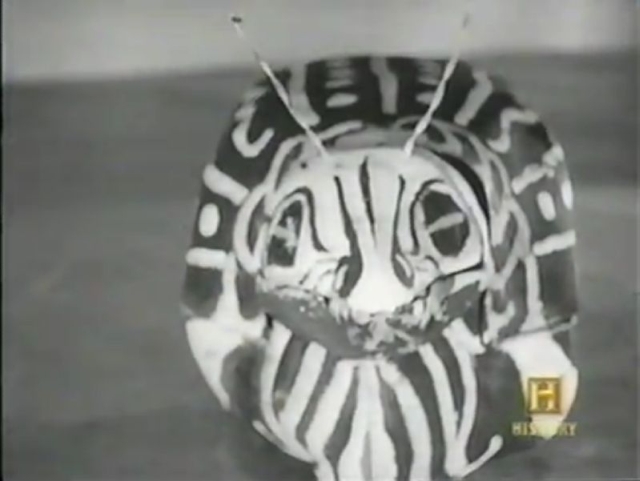
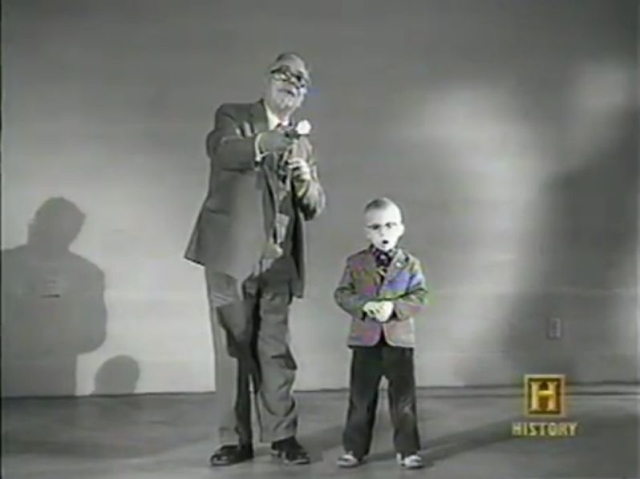
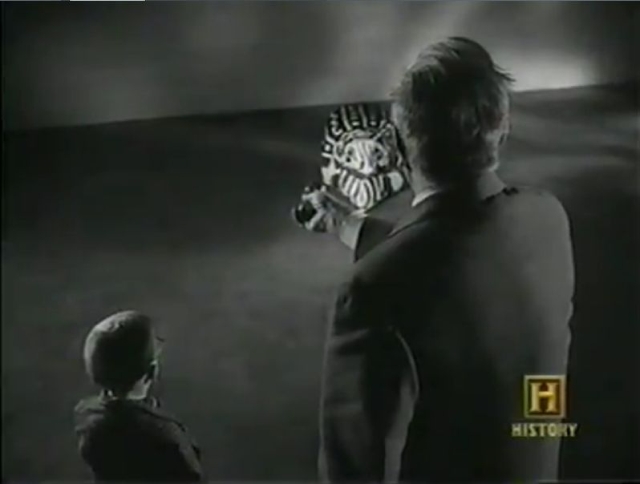
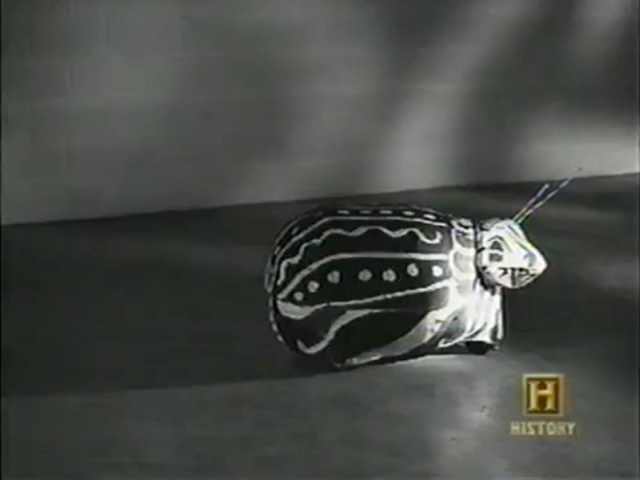
The Photo-cells are fixed, effectively on each front corner of the cart, so Wiener shines the torch not in the animal's "eyes" in its steerable head, but on it's "shoulder" instead.
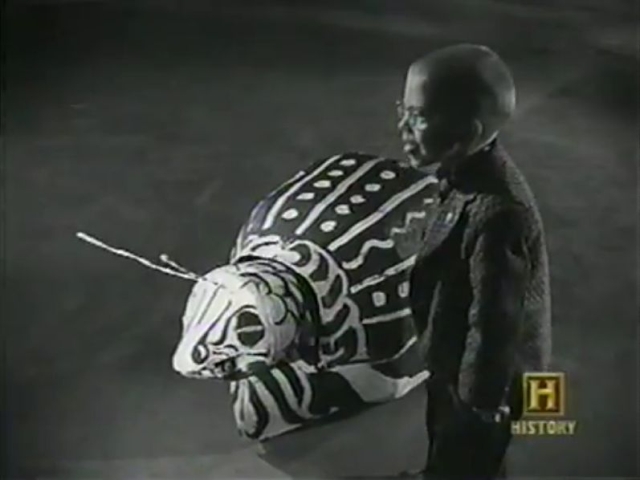
See video clip below 1min in for 25 seconds.
Fantastic website! I am just seeing it for the first time. My doctoral work was on epistemology and evolutionary robotics (c. 1989) and I have written about Ashby's hemostat and Pask's electrochemical device. I can send you some papers if you like. Thanks so much for putting all this together.